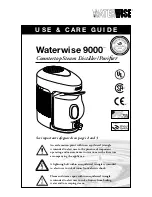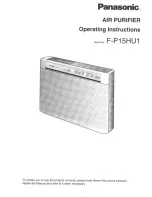
6
GB
D
F
E
I
NL
P
GR
RU
TR
CZ
SV
HG
PO
Contents
1. Safety precautions
1.1. Before installation and electric work
s
Before installing the unit, make sure you read all the “Safety
precautions”.
s
The “Safety precautions” provide very important points re-
garding safety. Make sure you follow them.
Symbols used in the text
Warning:
Describes precautions that should be observed to prevent danger of injury
or death to the user.
Caution:
Describes precautions that should be observed to prevent damage to the
unit.
Symbols used in the illustrations
: Indicates an action that must be avoided.
: Indicates that important instructions must be followed.
: Indicates a part which must be grounded.
: Indicates that caution should be taken with rotating parts. (This symbol is
displayed on the main unit label.) <Color: Yellow>
: Beware of electric shock (This symbol is displayed on the main unit label.)
<Color: Yellow>
Warning:
Carefully read the labels affixed to the main unit.
Warning:
•
Ask the dealer or an authorized technician to install the air conditioner.
- Improper installation by the user may result in water leakage, electric shock,
or fire.
•
This appliance is not intended for use by persons (including children)
with reduced physical, sensory or mental capabilities, or lack of experi-
ence and knowledge, unless they have been given supervision or in-
struction concerning use of the appliance by a person responsible for
their safety.
•
Install the air unit at a place that can withstand its weight.
- Inadequate strength may cause the unit to fall down, resulting in injuries.
•
Use the specified cables for wiring. Make the connections securely so
that the outside force of the cable is not applied to the terminals.
- Inadequate connection and fastening may generate heat and cause a fire.
•
Prepare for typhoons and other strong winds and earthquakes and in-
stall the unit at the specified place.
- Improper installation may cause the unit to topple and result in injury.
•
Always use an air cleaner, humidifier, electric heater, and other accesso-
ries specified by Mitsubishi Electric.
- Ask an authorized technician to install the accessories. Improper installation
by the user may result in water leakage, electric shock, or fire.
•
Never repair the unit. If the air conditioner must be repaired, consult the
dealer.
- If the unit is repaired improperly, water leakage, electric shock, or fire may result.
•
If the supply cord is damaged, it must be replaced by the manufacturer,
its service agent or similarly qualified persons in order to avoid a hazard.
•
Do not touch the heat exchanger fins.
- Improper handling may result in injury.
•
When handling this product, always wear protective equipment.
EG: Gloves, full arm protection namely boiler suit, and safety glasses.
- Improper handling may result in injury.
•
If refrigerant gas leaks during installation work, ventilate the room.
- If the refrigerant gas comes into contact with a flame, poisonous gases will
be released.
•
Install the air conditioner according to this Installation Manual.
- If the unit is installed improperly, water leakage, electric shock, or fire may result.
•
Have all electric work done by a licensed electrician according to “Elec-
tric Facility Engineering Standard” and “Interior Wire Regulations”and
the instructions given in this manual and always use a special circuit.
- If the power source capacity is inadequate or electric work is performed im-
properly, electric shock and fire may result.
•
Keep the electric parts away from water (washing water etc.).
- It might result in electric shock, catching fire or smoke.
•
Securely install the outdoor unit terminal cover (panel).
- If the terminal cover (panel) is not installed properly, dust or water may enter
the outdoor unit and fire or electric shock may result.
•
Do not use refrigerant other than the type indicated in the manuals pro-
vided with the unit and on the nameplate.
- Doing so may cause the unit or pipes to burst, or result in explosion or fire
during use, during repair, or at the time of disposal of the unit.
- It may also be in violation of applicable laws.
- MITSUBISHI ELECTRIC CORPORATION cannot be held responsible for mal-
functions or accidents resulting from the use of the wrong type of refrigerant.
•
If the air conditioner is installed in a small room, measures must be taken
to prevent the refrigerant concentration from exceeding the safety limit
even if the refrigerant should leak.
- Consult the dealer regarding the appropriate measures to prevent the safety
limit from being exceeded. Should the refrigerant leak and cause the safety
limit to be exceeded, hazards due to lack of oxygen in the room could result.
•
When moving and reinstalling the air conditioner, consult the dealer or
an authorized technician.
- If the air conditioner is installed improperly, water leakage, electric shock, or
fire may result.
•
After completing installation work, make sure that refrigerant gas is not
leaking.
- If the refrigerant gas leaks and is exposed to a fan heater, stove, oven, or
other heat source, it may generate noxious gases.
•
Do not reconstruct or change the settings of the protection devices.
- If the pressure switch, thermal switch, or other protection device is shorted
and operated forcibly, or parts other than those specified by Mitsubishi Elec-
tric are used, fire or explosion may result.
•
To dispose of this product, consult your dealer.
•
Do not use a leak detection additive.
•
The installer and system specialist shall secure safety against leakage
according to local regulation or standards.
- Following standards may be applicable if local regulation are not available.
•
Pay a special attention to the place, such as a basement, etc. where re-
frigeration gas can stay, since refrigeration is heavier than the air.
•
Children should be supervised to ensure that they do not play with the
appliance.
1.2. Precautions for devices that use R410A
refrigerant
Caution:
•
Do not use the existing refrigerant piping.
- The old refrigerant and refrigerator oil in the existing piping contains a large
amount of chlorine which may cause the refrigerator oil of the new unit to
deteriorate.
•
Use refrigerant piping made of C1220 (Cu-DHP) phosphorus deoxidized
copper as specified in the JIS H3300 “Copper and copper alloy seamless
pipes and tubes”. In addition, be sure that the inner and outer surfaces
of the pipes are clean and free of hazardous sulphur, oxides, dust/dirt,
shaving particles, oils, moisture, or any other contaminant.
- Contaminants on the inside of the refrigerant piping may cause the refriger-
ant residual oil to deteriorate.
1. Safety precautions ...................................................................................... 6
1.1. Before installation and electric work .......................................... 6
1.2. Precautions for devices that use R410A refrigerant .................. 6
1.3. Before getting installed .............................................................. 7
1.4. Before getting installed (moved) - electrical work ...................... 7
1.5. Before starting the test run ........................................................ 7
2. Indoor unit accessories ............................................................................... 7
3. Selecting an installation site ....................................................................... 7
3.1. Mount filter before hanging up the Indoor unit to the position ... 8
3.2. Install the indoor unit on a ceiling strong enough to sustain
its weight ................................................................................... 8
3.3. Securing installation and service space .................................... 8
3.4. Combining indoor units with outdoor units ................................ 8
4. Fixing hanging bolts .................................................................................... 8
4.1. Fixing hanging bolts .................................................................. 8
5. Changing Bottom Inlet Specifications ......................................................... 8
6. Installing the unit ......................................................................................... 8
6.1. Hanging the unit body ............................................................... 8
6.2. Confirming the unit’s position and fixing hanging bolts ............. 8
7. Refrigerant pipe and drain pipe specifications ............................................ 9
7.1. Refrigerant pipe and drain pipe specifications .......................... 9
7.2. Refrigerant pipe, drain pipe and filling port ............................... 9
8. Connecting refrigerant pipes and drain pipes ............................................. 9
8.1. Refrigerant piping work ............................................................. 9
8.2. Drain piping work ....................................................................... 9
9. Duct work .................................................................................................. 10
10. Electrical wiring ......................................................................................... 10
10.1. Power supply wiring ................................................................. 10
10.2. Connecting remote controller, indoor and outdoor
transmission cables ................................................................. 11
10.3. Connecting electrical connections ........................................... 12
10.4. Selecting the power source ..................................................... 12
10.5. Setting addresses .................................................................... 12
10.6. Sensing room temperature with the built-in sensor in
a remote controller .................................................................. 12
10.7. External I/O specifications ....................................................... 12
10.8. Electrical characteristics .......................................................... 12
WT04891X03_en.p65
2012.7.20, 5:30 PM
6







































